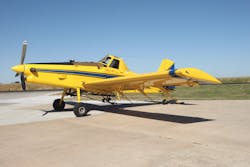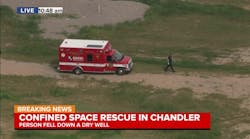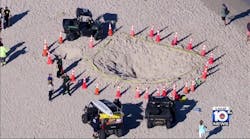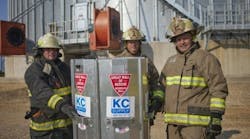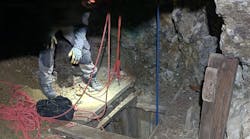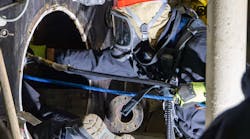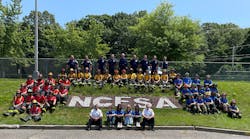Thousands of agricultural spraying, loading and fueling operations are carried out each season without incident, but when accidents occur, fire-rescue personnel may encounter hazardous chemicals contaminating equipment, protective clothing and themselves.
Agricultural production in America has progressed greatly in the past century. In 1910, one farmer fed seven Americans; today, one farmer feeds 143 Americans. This increase can be attributed to improved hybrids, crop rotation, improved tilling methods and the application of pesticides to control pests that damage crops.
Pesticides include a broad range of chemicals used to control everything from insects and rodents to weeds, fungus and worms. Chemicals can also be sprayed on crops such as sunflowers to hasten the drying process for harvest. Dry application of pesticides is limited to crops like rice and other specialized situations. Ninety-five percent of all pesticide application is done through spraying.
Aerial application
The primary method used to apply pesticides to crops is aerial spraying. The aircraft vary from helicopters and biplanes to specially designed, fixed-wing craft. There are several manufacturers of fixed-wing aircraft, including Air Tractor and Thrush, the primary manufacturers of turbine aircraft, in which the engines are inside the shell of the aircraft. Turbine engines use Jet A, a kerosene-type fuel, and Jet B, a naphtha-type fuel that enhances cold-weather performance. Cessna and Piper manufacture agricultural spray aircraft, mostly with piston engines that use gasoline for fuel. Piston aircraft are characterized by the engine being located on the outside of the aircraft. Ag-Cat is the primary manufacturer of biplanes (two-winged aircraft with one wing stacked a few feet above the other). These aircraft may have turbine or piston engines.
Aircraft can be found applying pesticides in the fruit orchards from Washington state to Pennsylvania and Florida; the Midwest crop fields to the vegetable fields of Maine, Idaho and California and everywhere in between. Anytime aircraft operate as crop sprayers, there is the possibility of accidents in the air and on the ground and in fixed storage. Accidents may involve fueling of the aircraft, fuel storage, mixing of pesticides, storage of pesticides and loading of pesticides on aircraft. These aircraft fly low to put maximum product on crops while avoiding pesticide drift. They face the hazards of power lines, trees and other natural barriers and aircraft failure.
Much spraying is done early or late in the day when wind is light. These are, however, times when the sun is low to the horizon and may cause visibility problems for pilots. Accidents may also occur at fixed bases when pesticides are mixed or loaded onto aircraft or during fueling. While not common, fires can occur where pesticides are stored. The decision whether to fight the fire or let it burn should be made after consulting the environmental protection organization with jurisdiction for the area.
Working in danger zones
While many pesticides used today are far safer than those used in the past, and few are life threatening, caution must be exercised until the product is identified and while working in contaminated areas. (One exception is Lorsban, a very toxic organophosphate pesticide.)
Pesticides encountered at accident scenes are likely to be diluted with water or granular. Regardless of the form, emergency response personnel must take precautions – as in any hazardous materials incident – before beginning firefighting or rescue operations. Not only could there be chemical contamination of the aircraft, pilot and immediate area, but the area sprayed may also be contaminated. Emergency personnel may have to pass through a treated area to reach the pilot. Even though chemical activity of many pesticides is short term when applied, response personnel may not have this information. Often, a pilot who knows a crash is imminent will try to dump the aircraft’s entire load of pesticide at once, spreading more contamination over the area.
Pilots of aerial spraying aircraft usually do not have radio contact with emergency dispatch centers and cannot in most instances talk to them on cockpit radios. Radios used by the aerial applicators are usually tied to operations bases that may or may not be manned at any given time. Around large metropolitan areas, pilots may have radio contact with air traffic control, but that is not the case in most rural areas. Many pilots carry cell phones, but otherwise have no way to communicate with emergency responders from the cockpit.
Identifying a pesticide
The first step when arriving at the scene of a pesticide accident is to identify the pesticide being used. If the pilot is conscious, he or she may be able to identify the pesticide. If not, contact the spray operator’s base of operations or the owner of the land being sprayed. Another spray applicator may also be able to provide information. Having a pesticide-label book or The Pesticide Handbook is helpful in identification. You can put together a label book based on pesticides in use in your response area. Labels can be obtained from the pesticide dealer or manufacturers’ websites.
Labels contain one of three “Signal Words” indicating the level of toxicity of the product. “Caution” means the material has low toxicity. The oral lethal dose of a 150-pound human is one ounce to more than a pint. “Warning” means the pesticide is moderately toxic and the oral lethal dose is one teaspoon to one tablespoon. “Danger” means the pesticide is highly toxic with the oral lethal dose being a few drops to one teaspoon. Material Safety Data Sheet (MSDS) are also available from dealers and online.
Most pesticides control specific kinds of pests and are applied at designated times of the year. Pesticides applied include herbicides for killing weeds, which may be applied early in the growing season; fungicides applied after crops start to mature; and insecticides, depending on the type of pest present. Agricultural pesticide applicators should be able to identify the potential type of pesticide being applied based on the crop and time of year. Most spray-plane operators use only a small number of specific chemicals in a particular area, so it is not difficult to visit applicators in a fire department’s first-due area to learn about inventory. Chemicals used for corn, wheat, soybeans and milo are much the same in all agricultural areas, but other crops may require pesticides unique to your area.
Assume the worst
If identification of a pesticide at an accident scene is not possible, assume you are dealing with a highly toxic chemical and protect personnel accordingly. If the pesticide turns out to be a low-toxicity material, no harm will be done. Small amounts of certain pesticides entering the body can cause serious illness or death. Harmful amounts can enter the body through skin absorption, inhalation, ingestion or injection. Primarily entry points through inhalation and contact with the skin are most common. Injection may occur when working around damaged aircraft that is contaminated and injury occurs that breaks the skin. Ingestion may occur when proper decontamination does not occur before smoking, drinking or eating following entry to the contaminated area.
Fire department bunker gear is not designed for chemical exposures and may provide only limited skin protection, if any. Once exposed to certain pesticides, most bunker gear cannot be decontaminated without damage. Manufacturers of pesticides and bunker gear should be consulted when contamination occurs. Self-contained breathing apparatus (SCBA) will likely prevent inhalation of toxic vapors, but can become contaminated. If contaminated bunker gear continues to be worn, firefighters may expose themselves to the pesticides over and over. Using proper protective clothing is the best safeguard against dermal exposure to pesticides. Protective clothing requirements are often listed on product labels or a pesticide’s MSDS.
Treat pesticides diluted or full strength as you would any other hazardous material until it is identified and the hazards are known. Common signs of pesticide poisoning are headache, dizziness, excessive perspiration, unclear vision, vomiting, muscle pain, stomachache and cramps. These also can be signs of other, less-serious illnesses, but if they occur after an incident involving pesticides, have them checked out. Trouble breathing, drooling at the mouth and nose, constricted pupils and fainting are signs of serious poisoning that could result in death. When a patient is suspected of pesticide exposure, take the pesticide label to the hospital with the patient. This may help the physician treat the patient. Do not take the pesticide container to the hospital because this may contaminate the ambulance or hospital emergency department.
Transporting patients
When handling and transporting contaminated patients to the hospital, make sure precautions are taken to protect personnel, equipment and the transport vehicle from contamination. Ensure that the hospital you are going to has the capability to handle patients with chemical contamination; otherwise, you will spread the contamination. Treatment may be delayed if you are turned away from a hospital that is not capable of handling contaminated patients.
Notify the medical facility as soon as possible so it can prepare. Once the material has been identified and proper protective clothing has been selected and put into use, make sure only the necessary number of personnel are used. Keeping other personnel and bystanders away from the area will reduce contamination.
Pre-planning procedures
As part of pre-incident planning, become familiar with the pesticide applicators in your response area. Visit them and note aircraft controls and safety features. Safety levers open aircraft doors from the outside, allowing access to the pilot. These are usually marked “Rescue” and allow the doors to be completely removed so they will not bar access to the pilot. A single escape lever will release the pilot’s safety harness in an emergency. Know the location of shutoff valves for the chemical tanks and bins as well as the fuel tanks. Become familiar with storage and loading facilities used by the applicator, since fires and spills can occur during filling and mixing and in storage. Know whether storage tanks contain full-strength or diluted pesticides, as characteristics can change drastically.
In fixed storage, pesticides are full strength when in original containers. The container types vary from several gallons to 250 gallons. They are required by the Occupational Health and Safety Administration (OSHA) to be placarded and labeled in storage as they are in transportation until the product is used up and the container is purged. This may make a difference in protective clothing requirements or the flammability and toxicity of the chemicals.
Additional information on pesticides, aerial spraying and training can be obtained from state and national trade organizations. Agricultural spraying aircraft may also be used to drop water on fires in grass or brush, and could become involved in accidents.
Thanks to Roth Aerial Spraying of Milford, NE, and Jim’s Agri-Air of Sutton, NE, for technical assistance and photo opportunities in the preparation of this column.
